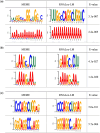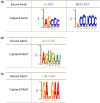RNALoc-LM: RNA subcellular localization prediction using pre-trained RNA language model
- PMID: 40119908
- PMCID: PMC11978386
- DOI: 10.1093/bioinformatics/btaf127
RNALoc-LM: RNA subcellular localization prediction using pre-trained RNA language model
Abstract
Motivation: Accurately predicting RNA subcellular localization is crucial for understanding the cellular functions and regulatory mechanisms of RNAs. Although many computational methods have been developed to predict the subcellular localization of lncRNAs, miRNAs, and circRNAs, very few of them are designed to simultaneously predict the subcellular localization of multiple types of RNAs. In addition, the emergence of pre-trained RNA language model has shown remarkable performance in various bioinformatics tasks, such as structure prediction and functional annotation. Despite these advancements, there remains a significant gap in applying pre-trained RNA language models specifically for predicting RNA subcellular localization.
Results: In this study, we proposed RNALoc-LM, the first interpretable deep-learning framework that leverages a pre-trained RNA language model for predicting RNA subcellular localization. RNALoc-LM uses a pre-trained RNA language model to encode RNA sequences, then captures local patterns and long-range dependencies through TextCNN and BiLSTM modules. A multi-head attention mechanism is used to focus on important regions within the RNA sequences. The results demonstrate that RNALoc-LM significantly outperforms both deep-learning baselines and existing state-of-the-art predictors. Additionally, motif analysis highlights RNALoc-LM's potential for discovering important motifs, while an ablation study confirms the effectiveness of the RNA sequence embeddings generated by the pre-trained RNA language model.
Availability and implementation: The RNALoc-LM web server is available at http://csuligroup.com:8000/RNALoc-LM. The source code can be obtained from https://github.com/CSUBioGroup/RNALoc-LM.
© The Author(s) 2025. Published by Oxford University Press.
Figures





Similar articles
-
2OMe-LM: predicting 2'-O-methylation sites in human RNA using a pre-trained RNA language model.Bioinformatics. 2025 Aug 2;41(8):btaf417. doi: 10.1093/bioinformatics/btaf417. Bioinformatics. 2025. PMID: 40728934 Free PMC article.
-
LncLocFormer: a Transformer-based deep learning model for multi-label lncRNA subcellular localization prediction by using localization-specific attention mechanism.Bioinformatics. 2023 Dec 1;39(12):btad752. doi: 10.1093/bioinformatics/btad752. Bioinformatics. 2023. PMID: 38109668 Free PMC article.
-
Deep learning model for protein multi-label subcellular localization and function prediction based on multi-task collaborative training.Brief Bioinform. 2024 Sep 23;25(6):bbae568. doi: 10.1093/bib/bbae568. Brief Bioinform. 2024. PMID: 39489606 Free PMC article.
-
Comprehensive review and assessment of computational methods for predicting RNA post-transcriptional modification sites from RNA sequences.Brief Bioinform. 2020 Sep 25;21(5):1676-1696. doi: 10.1093/bib/bbz112. Brief Bioinform. 2020. PMID: 31714956 Review.
-
Decoding subcellular RNA localization one molecule at a time.Genome Biol. 2025 Mar 3;26(1):45. doi: 10.1186/s13059-025-03507-8. Genome Biol. 2025. PMID: 40033325 Free PMC article. Review.
Cited by
-
Leveraging protein language models for cross-variant CRISPR/Cas9 sgRNA activity prediction.Bioinformatics. 2025 Jul 1;41(7):btaf385. doi: 10.1093/bioinformatics/btaf385. Bioinformatics. 2025. PMID: 40600900 Free PMC article.
-
2OMe-LM: predicting 2'-O-methylation sites in human RNA using a pre-trained RNA language model.Bioinformatics. 2025 Aug 2;41(8):btaf417. doi: 10.1093/bioinformatics/btaf417. Bioinformatics. 2025. PMID: 40728934 Free PMC article.
References
-
- Ahmad A, Lin H, Shatabda S. Locate-R: subcellular localization of long non-coding RNAs using nucleotide compositions. Genomics 2020;112:2583–9. - PubMed
-
- Asim MN, Ibrahim MA, Zehe C et al. L2S-MirLoc: a lightweight two stage MiRNA sub-cellular localization prediction framework. In: 2021 International Joint Conference on Neural Networks (IJCNN), Shenzhen, China. New York, USA: IEEE, 2021, 1–8.
-
- Bai T, Yan K, Liu B. DAmiRLocGNet: miRNA subcellular localization prediction by combining miRNA–disease associations and graph convolutional networks. Brief Bioinf 2023;24:bbad212. - PubMed
MeSH terms
Substances
Grants and funding
LinkOut - more resources
Full Text Sources
Miscellaneous

